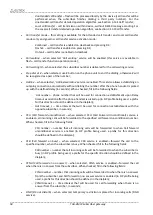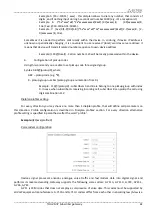
____________________________________________________________________________________
____________________________________________________________________________________
60
TAU-4M.IP Subscriber gateway
Interdigit Short Timer
('S' digit in dialplan entry)
- next digit input waiting time, if there is at least
one pattern that appropriate for dialed combination, and at least one more that needs extension
dialing.
Additional features:
1.
Dialed sequence replacement
Syntax:
<arg1:arg2>
This ability allows to replace the dialed sequence to any dialed symbols sequence. In doing so, the
second argument should be set as a defined value, both arguments can be empty.
–
Example: (<83812:> XXXXXX) - this record will comply to dialed digits 83812, but this
sequence will omitted and will not be transmitted to SIP server.
2.
Tone insert into dial
For long-distance access (for city access in case of office PBX), it is common to hear a ringback, that
may be implemented by inserting comma in a sequence of digits.
–
Example: (8, 770) - after digit 8 a continuous tone will output when dialing number 8770.
3.
Number dialling deny.
If at the end of pattern add symbol '!' the dialling of numbers corresponding to the template will be
blocked.
–
Example: (8 10X xxxxxxx ! | 8 xxx xxxxxxx ) - expression allows dialling only intercity
numbers and exclude international calls.
4.
Replacement of number dialling timers values
Timer values may be specified for a complete dialplan, as well as for the specific pattern. Character 'S'
is responsible for
'Interdigit Short Timer'
setting and 'L' for
'Interdigit Long Timer'
. Timer values may be
specified for all templates in a dialplan if values are listed before the opening parenthesis.
–
Example: S4 (8XXX.) or S4,L8 (XXX)
If these values are listed in one sequence only, they are effective only for this sequence. Also, in this
case, you should not set a colon between timeout key and value; a value can be placed in any part of
pattern.
–
Example: (S4 8XXX. | XXX) or ([1-5] XX S0) - entry will call instant call transmission when
three-digit number starting at 1, 2, ..., 5 is dialed.
5.
Direct address dial (IP Dialling)
Symbol '@', set after number, means that server address, where call will be transmitted will be set
next. We recommend to use
'IP Dialling'
and receive and transmission of call without registration
('Call
Without Reg', 'Answer Without Reg')
. It may help in case of server failure.
Moreover, IP Dialing address format can be used in numbers, intended for call forwarding.
–
Example 1: ( 8 xxx xxxxxxx ) - 11-digit number, starting at 8.
–
Example 2: ( 8 xxx xxxxxxx | <:8495> xxxxxxx ) - 11-digit number, starting at 8; add 8495 to
transmitting number if 7-digit number is entered.
–
Example 3: (0[123] | 8 [2-9]xx [2-9]xxxxxx) - the emergency services and some intercity
numbers dialling.
–
Example 4: (S0 <:82125551234>) - specified number speed dial, 'Hotline' mode analogue
on another gateways.
















































